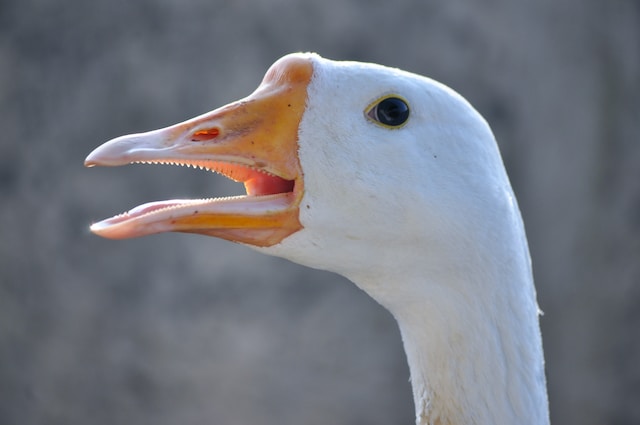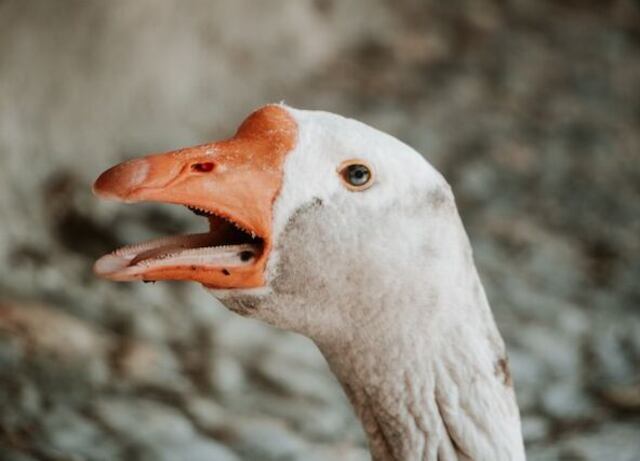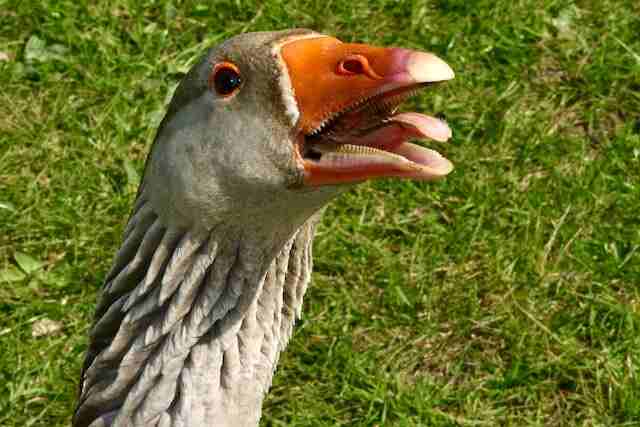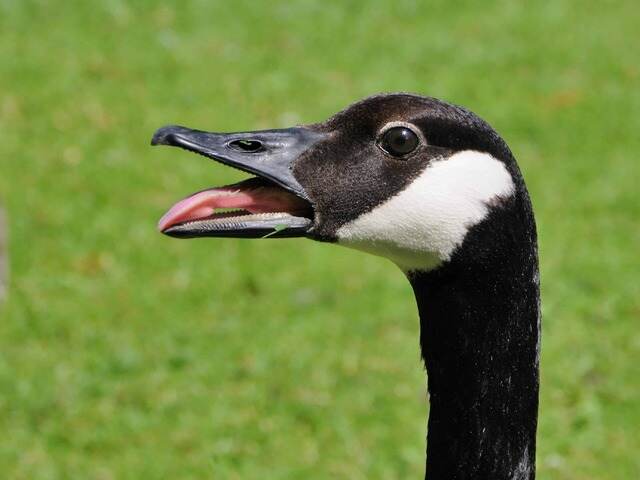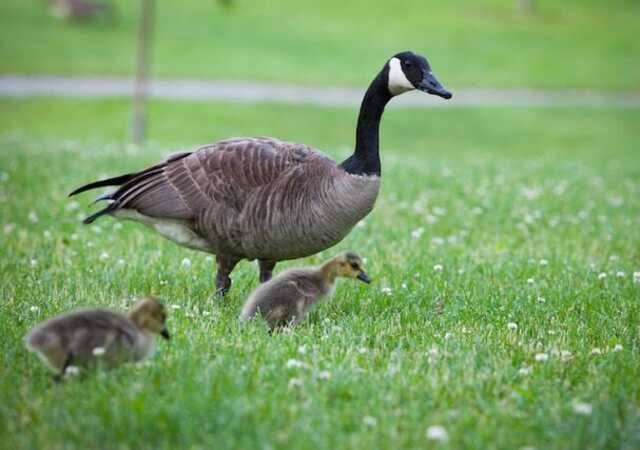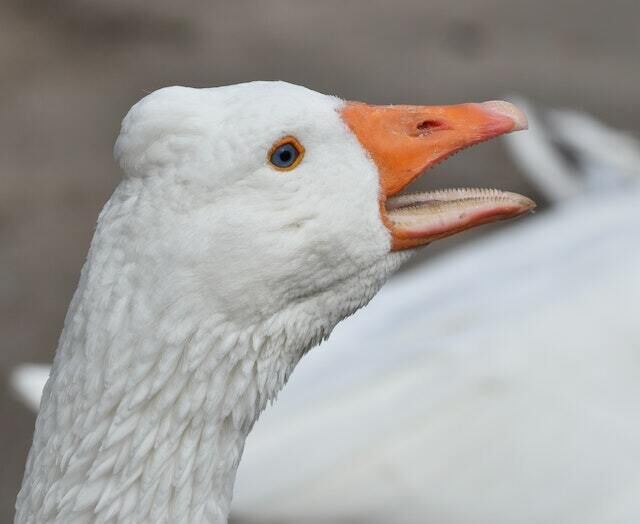Do geese have teeth? The answer is simple: no, they don’t. But hold on a moment before you roll your eyes and move on to the next article. Despite their toothless nature, geese have some fascinating adaptations that make them one of the most formidable birds out there.
From their serrated beaks to their unique feeding habits, these feathered creatures are full of surprises. So buckle up and get ready to discover the curious world of geese and their toothless wonders.
Table of Contents
Overview of Geese Teeth
Geese are known for their aggressive behavior and their sharp, serrated beaks that can cause serious injury. However, many people wonder if geese have teeth.
Geese lack traditional teeth, but possess tooth-like formations along their bill’s interior and tongue’s edges. The ridged structures, referred to as tomia, are equipped with sharp lamellae, resembling a saw blade.
What Are “Geese Teeth”?
Geese teeth are not true teeth, but are instead hard, spiky cartilage that protrudes from the inside of their beaks and tongues.
These structures are called tomia and are used by geese to grip and tear food. The serrated edges of the tomia allow geese to slice through tough vegetation and prey with ease.
Are “Geese Teeth” Really Teeth?
While the tomia of geese may look and function like teeth, they are not considered teeth in the traditional sense. Unlike mammalian teeth, which are made of enamel and dentin, the tomia of geese are made of keratin, the same material that makes up hair and nails.
Do Geese Have Teeth on Their Tongues?
In addition to the tomia in their beaks, geese also have tooth-like structures on their tongues. These structures are also made of keratin and help geese grip and manipulate their food.
Purpose of Geese Teeth on Their Tongues
The tooth-like structures on the tongues of geese serve a similar purpose to the tomia in their beaks. They allow geese to grip and tear food, making it easier to swallow.
Additionally, the serrated edges of the tomia and tongue structures can help geese defend themselves against predators.
Overall, while geese do not have traditional teeth, their tomia and tongue structures serve a similar purpose.
These tooth-like structures allow geese to grip and tear food, making it easier to swallow and defend themselves against predators.
| Question | Answer |
|---|---|
| What are “Geese Teeth”? | Hard, spiky cartilage called tomia that protrude from the inside of their beaks and tongues. |
| Are “Geese Teeth” really teeth? | No, they are not considered teeth in the traditional sense and are made of keratin. |
| Do geese have teeth on tongues? | Yes, they have tooth-like structures made of keratin that help them grip and manipulate food. |
| Purpose of Geese Teeth on Tongues | Similar to tomia, they help geese grip and tear food, making it easier to swallow and defend themselves against predators. |
Geese Behavior
Geese are known for their aggressive behavior, especially during their breeding season. It is essential to understand their behavior to avoid any potential attacks.
In this section, we will discuss the aggression in geese, how to identify aggressive geese, avoiding a goose attack, dealing with a goose attack, and other ways geese attack.
Aggression in Geese
Geese can be very territorial and aggressive during their breeding season, which usually lasts from March to June. They are known to attack humans, other animals, and even cars.
Geese can become aggressive if they feel threatened, cornered, or if their goslings are in danger. They can also become aggressive if they are protecting their nesting sites.
How to Identify Aggressive Geese
It is essential to identify aggressive geese to avoid any potential attacks. Aggressive geese usually have their wings slightly open, their necks stretched out, and their bills open. They may also hiss or honk loudly, and their eyes may appear angry or agitated.
Avoiding a Goose Attack
The best way to avoid a goose attack is to stay away from them. If you must walk near a nesting site, give them plenty of space and avoid eye contact.
Do not approach them or try to touch them, and do not feed them. Feeding geese can make them more aggressive and dependent on humans for food.
Dealing with a Goose Attack
If a goose attacks, the best thing to do is to stay calm and slowly back away. Do not run or make sudden movements, as this can provoke the goose to attack further.
Use an object such as an umbrella or a jacket to shield yourself from the goose’s beak and wings. If you are with other people, stick together and make loud noises to scare the goose away.
Other Ways Geese Attack
Geese can attack in other ways besides using their beaks and wings. They may also chase people, bite, or grab clothing or hair. In some cases, geese may even fly towards people, trying to knock them over.
It is essential to be aware of these other attack methods and take precautions to avoid them. In conclusion, understanding geese behavior is essential to avoid any potential attacks.
Geese can be aggressive, especially during their breeding season, and it is crucial to identify their behavior to avoid any potential danger.
By following the guidelines mentioned above, you can minimize the risk of a goose attack.
Geese and Chickens
Geese and chickens are both domesticated birds that are commonly found on farms and in backyards. Although they have many similarities, there are also significant differences between the two.
Beaks
One major difference between geese and chickens is their beaks. Geese have long, pointed beaks that are designed for grazing on grass and other vegetation. They also have tooth-like structures called tomia that line the inside of their beaks and the edge of their tongues.
These structures are ridged with sharp lamellae and act similarly to regular teeth, but lack any enamel. Chickens, on the other hand, have shorter, blunter beaks that are better suited for pecking at seeds and insects.
Diet
Another difference between geese and chickens is their diet. Geese are primarily herbivorous and feed on grasses, grains, roots, and tough low-growing vegetation.
They also eat insects and small rodents on occasion. Chickens, on the other hand, are omnivorous and will eat a wide variety of foods, including seeds, insects, fruits, and vegetables.
Temperament
Geese and chickens also have different temperaments. Geese are known for being more aggressive and territorial than chickens, especially during breeding season.
They are also more likely to bite and attack humans who they perceive as a threat to their territory or offspring.
Chickens, on the other hand, are generally more docile and easy to handle, making them a popular choice for backyard flocks.
Egg Laying
Finally, geese and chickens differ in their egg-laying habits. Geese lay fewer eggs than chickens and only during the breeding season, which typically lasts from February to May.
They also require a longer period of incubation before the eggs hatch, which can range from 28 to 35 days. Chickens, on the other hand, lay eggs year-round and require a shorter incubation period of around 21 days.
Overall, while geese and chickens share some similarities, they are also quite different in terms of their beaks, diet, temperament, and egg-laying habits. Understanding these differences can help farmers and backyard enthusiasts choose the right bird for their needs.
Geese Tongue
Geese are known for their distinctive honking calls and their unique V-formation flight pattern. However, one aspect of geese that often goes unnoticed is their tongue.
In this section, we will explore the appearance of goose tongue, teeth on goose tongue, serrated tongues in geese, goose bite, and pain.
Appearance of Goose Tongue
The tongue of a goose is a muscular organ that is located in the oral cavity. It is covered with small, spiky protrusions known as papillae. These papillae give the tongue a rough texture, which helps geese grip and manipulate food.
Teeth on Goose Tongue
Contrary to popular belief, geese do not have teeth on their tongue. Instead, they have serrated edges on the sides of their beak, which they use to tear and shred food. These serrated edges are called tomia, and they are made of hard, spiky cartilage.
Serrated Tongues in Geese
Geese have serrated tongues, which are covered with small, sharp projections that help them grip and tear food. These projections are called papillae, and they are similar in appearance to teeth. However, they are not true teeth, as they do not contain dentin, enamel, pulp, and cementum.
Goose Bite
Geese have a powerful bite that can cause pain and injury to humans. Their beaks are designed to tear and shred food, and they can easily break skin. It is important to avoid provoking geese and to give them plenty of space.
Pain
A goose bite can be painful and may cause bruising, swelling, and bleeding. If you are bitten by a goose, it is important to clean the wound thoroughly and seek medical attention if necessary.
In summary, geese have a unique tongue with serrated edges that help them grip and tear food. While they do not have teeth on their tongue, their beak is designed to tear and shred food, and they have a powerful bite that can cause pain and injury.
Geese Eating Habits
Geese are herbivores, which means they feed on plants and vegetation. They have a varied diet that includes grasses, leaves, roots, and seeds. They also eat aquatic plants and algae, as well as grains and fruits.
Geese have a unique digestive system that allows them to extract nutrients from tough plants and seeds that other animals cannot digest.
Geese are grazers, which means they feed on plants that grow close to the ground. They use their bills to grip their food and to assist in tearing plants into manageable portions.
Interestingly, geese do not have teeth, but they have something called tomia. These sharp, tooth-like structures line their tongues and beaks and help them to grind up their food.
Geese are social birds and often feed in flocks. They have a keen sense of sight and can spot food from a distance. They also have a good memory and can remember where food sources are located.
Geese are opportunistic feeders and will take advantage of any available food source. In captivity, geese are often fed poultry feed, which is a mix of grains and seeds.
It is important to provide geese with a balanced diet that meets their nutritional needs. Overfeeding geese can lead to health problems, such as obesity and fatty liver disease.
In conclusion, geese have a varied diet that includes plants, vegetation, and grains. They are grazers and use their bills and tomia to grind up their food.
Geese are social birds and often feed in flocks. In captivity, they are often fed poultry feed, which should be balanced to meet their nutritional needs.
Geese Digestion
Geese, like all birds, have a unique digestive system that allows them to break down tough plant material. The digestive system of geese is adapted to their herbivorous diet, which consists mainly of grasses and other vegetation.
Anatomy of the Digestive System
The digestive system of geese consists of several organs, including the crop, proventriculus, gizzard, small intestine, and large intestine. The crop is a sac-like structure that stores food before it enters the proventriculus, where digestive enzymes and acids are secreted.
The gizzard, a muscular organ located between the proventriculus and the small intestine, grinds up food using small stones that the geese swallow.
The small intestine is where most of the nutrients are absorbed, while the large intestine is responsible for the absorption of water and the elimination of waste.
Adaptations for Herbivory
Geese have several adaptations that allow them to digest tough plant material. One of the most important adaptations is the presence of a muscular gizzard that can develop pressures of up to 275 mm Hg.
This allows geese to grind up tough plant material, such as grasses, which are difficult to digest. Additionally, geese have a long and convoluted small intestine, which provides more surface area for nutrient absorption.
Differences from Mammalian Digestion
Bird digestion differs significantly from mammalian digestion. And unlike mammals, birds do not have teeth to chew their food. Instead, they use their beaks and muscular gizzards to grind up food.
Additionally, birds have a unique digestive system that allows them to extract nutrients from tough plant material, which is not possible for most mammals. Overall, geese have a unique digestive system that allows them to digest tough plant material.
Their digestive system is adapted to their herbivorous diet, and includes several organs, such as the crop, proventriculus, gizzard, small intestine, and large intestine. Geese have several adaptations for herbivory, including a muscular gizzard and a long and convoluted small intestine.
Evolution of Geese Teeth
Geese are known for their sharp, pointed beaks that help them tear through tough vegetation. However, many people wonder if geese have teeth. The answer is no, but they do have tooth-like structures in their beaks that help them eat.
Toothless Birds
Birds are known for their beaks, which are used for a variety of purposes such as eating, grooming, and defense. Unlike mammals, birds do not have teeth in their mouths. Instead, they have evolved beaks that are adapted to their specific diets.
Herbivorous Birds
Geese are herbivorous birds, which means that they primarily eat plants. To help them eat tough vegetation, geese have evolved tooth-like structures in their beaks called tomia. These structures are ridged with sharp lamellae, which help geese tear through tough plant material.
Bird Teeth Evolution
Birds are descended from reptiles, which did have teeth. However, over time, birds have evolved to lose their teeth and develop beaks instead. This evolution has allowed birds to adapt to a wide range of diets and environments.
In conclusion, while geese do not have teeth, they do have tooth-like structures in their beaks that help them eat tough vegetation. This adaptation is just one example of how birds have evolved to adapt to their specific diets and environments.
FAQs: Do Geese Have Teeth?
Do goose bites hurt?
Yes, goose bites can be quite painful and cause bruises or injuries. Geese have strong bills that they use for biting and defense, which can result in painful bites.
Do geese have real teeth?
No, geese do not have real teeth like humans do. Instead, they have serrated edges on their bills that they use to grind and crush food.
Do Canada geese have teeth?
No, Canada geese do not have teeth. However, they have serrated bills that help them to break down and digest their food.
Are geese teeth sharp?
The edges of a goose’s bill are serrated and can be quite sharp, but they are not actual teeth. The sharp edges help geese to grip and break down tough plant materials.
Do Canada geese bite?
Yes, Canada geese can and will bite if they feel threatened or are defending their territory. It is best to keep a safe distance from them and avoid provoking them.
How many teeth do geese have?
Geese do not have actual teeth. Instead, their bills have serrated edges that help them to grind and crush their food. The number of serrations on a goose’s bill can vary, but they typically have between 50 and 70 serrations.
Conclusion
In summary, geese do not have teeth in the traditional sense, but they do have tomia, which are hardened pieces of cartilage on their beaks and tongues that act similarly to teeth. These tomia are razor-sharp and assist geese in gripping and tearing their food, such as plants and insects.
Although geese may appear to have teeth, they lack the enamel and protective layer covering mammals’ teeth, making their tomia fake teeth. Additionally, tomia are not limited to geese’s bills, and other birds, such as ducks and swans, also have them.
It is essential to note that geese are capable of biting and can cause harm if they feel threatened or provoked. A goose’s bite feels like a pinch and may not cause much pain, but it is still best to avoid provoking them.
Overall, while geese do not have teeth, their tomia serve a similar purpose and are essential to their survival. Understanding the unique features of geese and their beaks can help individuals appreciate and respect these fascinating creatures.


